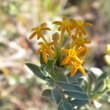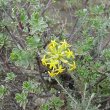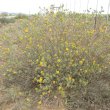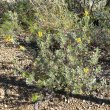Gnidia capitatum - Lasiosiphon capitatus
| Botanical Name | Gnidia capitatum - Lasiosiphon capitatus |
|||||||||||
| Family | Thymelaeaceae - The fibre-bark and gonna family. |
|||||||||||
| Pronunciation | NY-dee-uh kap-ih-TAY-tum |
|||||||||||
| Common Name(s) |
Afrikaans: Gifbossie; Kerrieblom; Kerriebossie
IsiXhosa: Isidikili; umsila wengwe
IsiZulu: Isidikili
Sesotho: Thopana; Thopa; Thopa-e-nyenyane; Setele
Setswana: kgôsi-ya-ditlhare
|
|||||||||||
| Plant Group |
|
|||||||||||
| Plant Size |
|
|||||||||||
| Position |
|
|||||||||||
| General Information |
|
|||||||||||
| Specific Information | Gnidia capitatum is a small, low branching, shrub. Leaves are quite small, broad and sharply pointed. They are slightly hairy with an attractive silvery-white margin. The stems become woody with age. |
|||||||||||
| Ad Break | ||||||||||||
| Flowers | ||||||||||||
| Description | a thin tube of about 3 - 4 cm long, flaring open with five narrow, pointed, slightly retracted lobes |
|||||||||||
| Season |
|
|||||||||||
| Colour |
|
|||||||||||
| Growth Rate |
|
|||||||||||
| Plant Uses |
|
|||||||||||
| Distribution and Habitat | in the provinces of the Eastern Cape, KwaZulu-Natal, Mpumalanga, Limpopo, North West, the Free State and Gauteng, as well as Botswana and Namibia, in arid, semi-arid scrub and grassland habitats |
|||||||||||
| Planting Suggestions | This is not a plant you would be able to find at a nursery, but it would appear that it could be a useful garden plant for dry gardens. Seeds would have to be collected, planted in well drained soil and kept moist but not wet. Young plants should be planted in full sun or with a little shade in well drained soil. Some compost and a thick layer of mulch will aid progress. Water frequently until well established then lengthen periods between water applications until the plant is water wise. It would probably a good idea to tip off growing points while the plant is still young to encourage bushiness. This plant looks as though it will tolerate only light pruning after flowering as I have found that woody shrubs do not always recover from severe cutting back. |
|||||||||||
| Lorraine's Garden Notes | I found almost no information about this plant and much of the content was gathered through my own observations. |
|||||||||||
| Medicinal Uses | Gnidia capitatum was used for stress-related ailments and the leaves were ground, then smoked, to treat stomach, ear and toothache. For headaches, the leaves were ground to a powder and used as snuff.Fresh, bruised leaves were made into poultice for toothache. A decoction of the roots was used to treat heartwater and anthrax in cattle. |
|||||||||||
| Ad Break | ||||||||||||








Discuss this plant
Share knowledge, ask a question or give an experience.